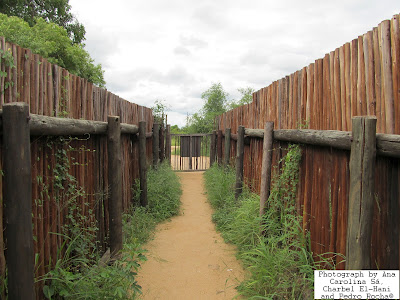Em Gardenia Hide, vimos bem de perto o Francolim-de-poupa (Dendroperdix sephaena) mostrado nas fotos abaixo, que estava forrageando próximo ao abrigo. Esta é uma ave com larga distribuição no continente africano, sendo encontrado no sul do Sudão e Etiópia, oeste da Somália, em Uganda, Quênia e Tanzânia, até Moçambique, Angola e nordeste da África do Sul. Ela habita ambientes savânicos ricos em árvores.
Este francolim é facilmente distinguido de outras espécies pela larga faixa branca acima dos cílios, que pode ser visualizada com clareza nas fotos acima. Esta faixa contrasta com a cor escura no topo da cabeça. A coloração branca na parte anterior do pescoço também é útil em sua identificação. O hábito de levantar a causa também ajuda a reconhecê-la.
As fêmeas e os juvenis não exibem estes caracteres de modo tão distintivo quanto os machos e, além disso, não possuem o esporão longo e curvado para cima presente nas pernas dos machos. O animal que vimos em Gardenia Hide era uma fêmea, considerando a falta do esporão e o seu tamanho.
São geralmente vistos aos pares ou em pequenos grupos e, como tivemos a oportunidade de perceber várias vezes no Kruger, freqüentemente são encontrados sobre o solo desnudo e inclusive nas estradas.
O Francolim-de-poupa é predado por várias espécies de águias e falcões. Ele se alimenta principalmente de insetos no verão, enquanto no inverno é predominantemente herbívoro, comendo rizomas e bulbos subterrâneos, bem como caules, folhas e frutos.
Trata-se de uma ave monogâmica, formando pares reprodutivos que podem durar até dez meses. Os machos competem e lutam pelas fêmeas, e a cópula segue um display ritual. Os ninhos são escondidos em meio a gramíneas e/ou arbustos, consistindo numa fenda no solo revestida com grama e folhas. A estação reprodutiva coincide com o período das chuvas, na África do Sul, entre Outubro e Março. São postos de 3 a 7 ovos, incubados pela fêmea por 19 a 26 dias, enquanto o macho guarda a área ao redor do ninho, emitindo um chamado de alerta para a fêmea caso surja algum perigo. Duas horas após a eclosão dos ovos, os filhotes deixam o ninho, sendo cuidados por seus pais.
Esta espécie não se encontra, de acordo com a Lista Vermelha da IUCN (União Internacional pela Conservação da Natureza), em risco de extinção. Essa classificação decorre de sua larga distribuição e da inferência de que seus tamanhos populacionais tendem a ser estáveis, embora não tenham sido quantificados. Esta inferência é baseada, por sua vez, na observação de que a espécie é comum e abundante ao longo de sua distribuição. Além disso, não há evidência de declínio populacional ou de ameaças substanciais. A fonte para as informações sobre o estado de conservação da espécie é: BirdLife International (2011) Species factsheet: Francolinus sephaena. Downloaded from http://www.birdlife.org on 22/11/2011.
In Gardenia Hide, we saw from a close range the Crested Francolin (Dendroperdix sephaena) shown in the pictures above, which was foraging nearby the hide. This is a bird with wide distribution in the African continent, being found in southern Sudan and Ethiopia, western Somalia, in Uganda, Kenya, Tanzania to Mozambique, Angola and northeast South Africa. It inhabits wooded savanna environments.
This francolin is easily distinguished from other species by its broad white superciliary stripe, which can be clearly seen in the pictures above. This stripe contrasts with the dark color at the top of the head. The white throat is also useful for the identification. Its habit of cocking its tail is also helpful in recognizing it.
Females and juveniles do not exhibit these traits in such a distinctive manner as the males, and, moreover, do not possess the long, upcurved leg spur of the males. The animal we saw in Gardenia Hide was a female, considering the lack of the spur and its size.
They are generally seen in pairs or small groups and, as we had the opportunity of perceiving several times in the Kruger, they are often found on bare ground, including roads.
Crested francolins are predated by several species of eagles and falcons. In summer it feeds mainly on insects while in winter it is mainly herbivorous, eating underground corms and bulbs, as well as above ground shoots, leaves, and fruits.
It is a monogamous bird, forming breeding pairs that can last for up to 10 months. Males compete and fight for the males, and the copulation involves a ritual display. Nests are hidden among grass and/or shrubs, consisting of a scrape in the ground lined with grass and leaves. The breeding seasons coincides with the rainy period, in South Africa, from October to March. From 3 to 7 eggs are laid, being incubated by the female from 19 to 26 days, while the male guards the area around the nest, emitting a warning call to the female in case of any danger. Two hours after the eggs hatch, the chicks leave the nest, being looked after by their parents.
This species is not, according to the IUCN (International Union for Conservation of Nature) Red List, in danger of extinction. This classification follows from its large distribution and the inference that its population sizes tend to be stable, although they have not been quantified. This inference is based, in turn, on the observation that the species is common and abundant along the range of its distribution. Moreover, there is no evidence of population decline or substantial threats. The source for the information on the conservation status of the species is: BirdLife International (2011) Species factsheet: Francolinus sephaena. Downloaded from http://www.birdlife.org on 22/11/2011.








